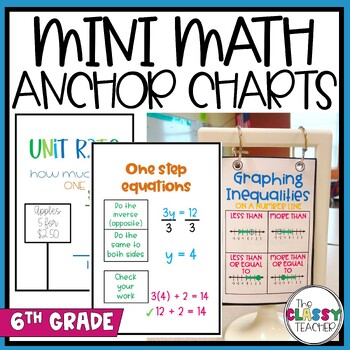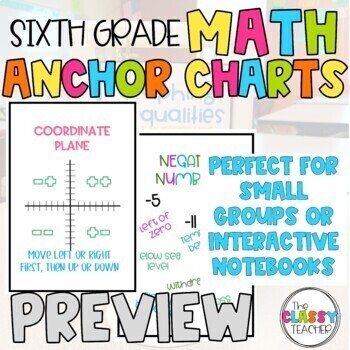Printable Math Anchor Charts (6th Grade)
- Zip
What educators are saying
Also included in
- Printable math anchor charts are the perfect solution to put an end to answering the same questions over and over when reviewing concepts. These ready-to-use anchor charts span four different grade levels ranging from 5th to 8th grade.These printable anchor charts cover a variety of topics with simpPrice $21.60Original Price $27.00Save $5.40
Description
Do you often find yourself giving your students reminders of all the little things they have learned throughout the year? These interactive math anchor charts are the perfect solution to help your students become more independent learners. Printable math anchor charts are the perfect tool for small group instruction, table group reference sheets, or interactive notebooks.
With this set, you will receive FOUR different sizes in both color and black and white.
- Frame Size (colored + black and white)
- 4x6 (colored + black and white)
- Half Sheet (colored + black and white)
- Full Sheet (colored + black and white)
This set of math anchor charts for 6th grade was designed to accompany those cute white frames from IKEA but they would also work perfectly in Interactive Notebooks or on a bulletin board.
Do you want your students to become independent learners? These printable math anchor charts are the perfect "assistant" for your students.
Want anchor charts at every table? With 4 different size options, these are great for small groups or even individual notebooks.
Topics in the set include:
Absolute Value
Adding & Subtracting Decimals
Area of Polygons
Coordinate Plane
Distributive Property
Dividing Decimals
Dividing Fractions
Graphing Inequalities
Greatest Common Factor
Mean Absolute Deviation
Measures of Central Tendency
Multiplying Decimals
One-Step Equations
Order of Operations
Percent of Quantity
Positive & Negative Numbers
Ratios
Ratio Table
Unit Rate
Volume
TEACHERS LIKE YOU SAID...
⭐⭐⭐⭐⭐ "I like the mini anchor charts that I can use with the ikea frames! This is very useful for my resource room. I have one set up at each table." - Falisha R.
⭐⭐⭐⭐⭐ "I LOVE these!!! I already had the frames from IKEA with Chromebook keyboard shortcuts in them, but my students this year are much more versed with their Chromebooks. I love that these mini anchor charts are easily accessible to students, visually appealing without being overstimulating, and I can prompt students to refer to them when I am reviewing material. This product is perfect in my Resource room." - First Year Scares Continued (TpT Seller)
⭐⭐⭐⭐⭐ "LOVE THIS! I have printed these in color for my classroom walls and printed in black and white for the students to put in their interactive notebook."
- Molly R.
Bundle and Save
Purchase the Anchor Charts Bundle to get this set of anchor charts plus 5th grade, 7th grade, and 8th grade anchor charts.
You might also like...
Sixth Grade Scavenger Hunts Bundle
Want to earn TPT Credit for future purchases?
Go to your "My Purchases" Page. Under each of your paid purchases, you will find the "Provide Feedback" option. Click it and you will have the opportunity to rate each of your purchased products earning credit to be used for future purchases.
This product may be used by you for your own personal use or in your classroom. If others are interested, please direct them to my TPT store where you can purchase an additional license for a discounted price. You may not post this product anywhere online that would give others access. Thank you for respecting my work.






